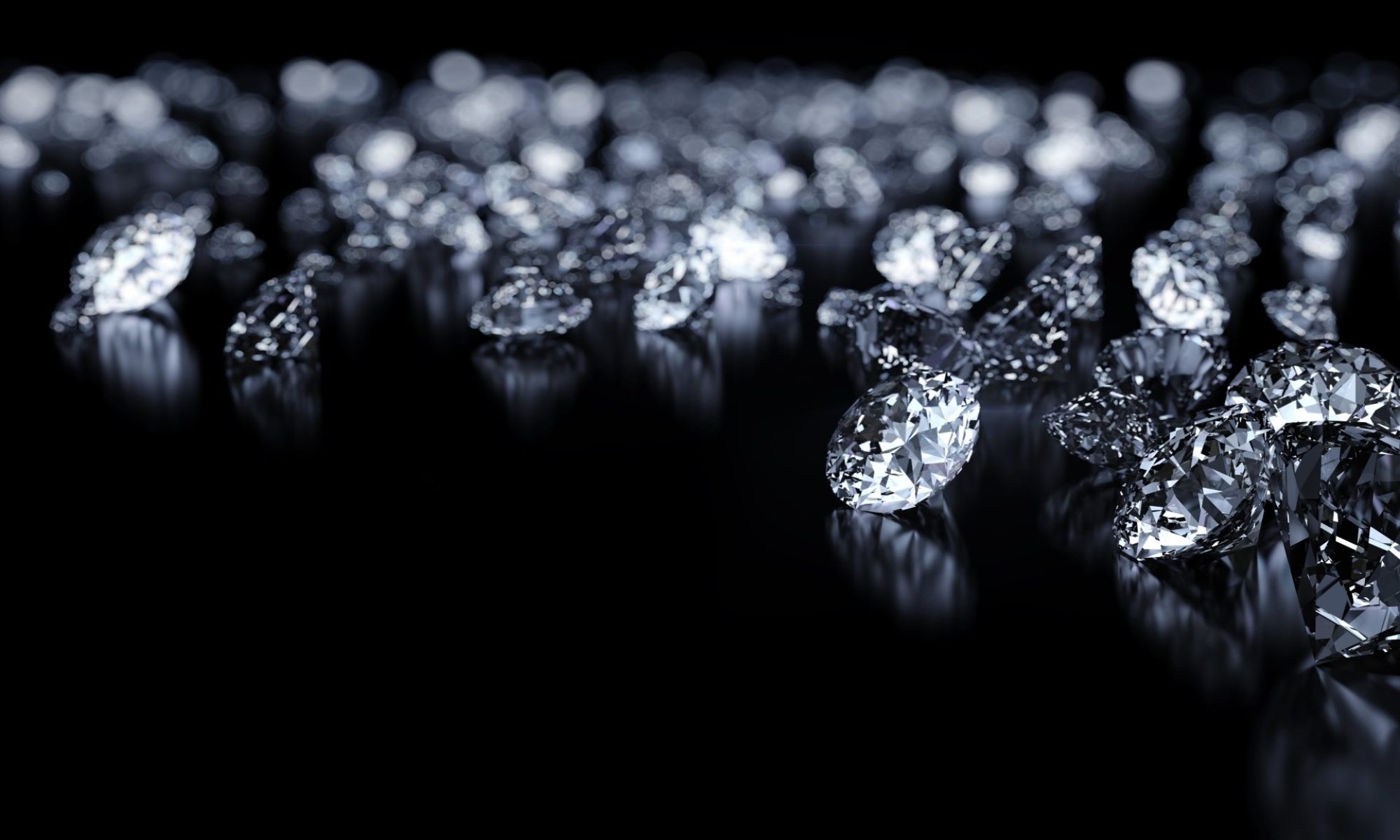Diamond Clarity
Clarity refers to the flaws in a diamond and is graded from Flawless (FL) to Included 3 (I3) by the GIA. The scale covers the following grades:
• Flawless (FL)
• Internally Flawless (IF)
• Very Very Slightly Included 1 (VVS1)
• Very Very Slightly Included 2 (VVS2)
• Very Slightly Included 1 (VS1)
• Very Slightly Included 2 (VS2)
• Slightly Included 1 (SI1)
• Slightly Included 2 (SI2)
• Included 1 (I1)
• Included 2 (I2)
• Included 3 (I3)
The most important thing you need to know about clarity is that it’s judged under 10x magnification. This means that if you look under higher magnification, it is possible to see flaws even in a diamond with a FL clarity grade. The point here is that flaws in a diamond is natural and all natural diamonds will have flaws at the microscopic level.
The reason behind the 10x magnification is that it is the standard for a jeweller’s loupe. This arbitrary standard for clarity grades doesn’t make sense to most for clarity grades above VS1 where it’s difficult to spot inclusions with a loupe. This is why it is recommended that you don’t weigh clarity as highly as color.
One thing that shoudl be pointed out is that there are 23 color grades and only 11 clarity grades. The range of diamonds that fall within each clarity grade are also wider at the low end than for color (most diamonds are H-color and gets more rare in either direction) so what you’ll find is that the price jump between an I and an H will be less than that between an SI1 and a VS2.
Clarity is something that people have the most diverging preferences. Some people like high clarity diamonds even if they cannot see the inclusions with their unaided eyes (mind-clean) and others just want to get the lowest clarity diamond that they can get away with without being able to see them (eye-clean).
Its recommended to find a reasonably high clarity like a good VS1, where it is difficult to spot an inclusion under 10x magnification (loupe-clean). Whichever clarity you choose, the important thing as always is that you understand and have good reasons for choosing it. This tutorial is designed to help you make this decision.
Flawless and Internally Flawless
IF means the diamond is without internal features. It turns out that clarity covers both internal and external features. Internal features are known as inclusions or ‘piqué’ and there are various types of inclusions (crystals, needle, feathers, clouds, pinpoints, indented natural, twining wisps, etc).
There are also various types of external features, also known as blemishes. Polish, as you know is a cut characteristic, but it also affects clarity. The difference between FL and IF is therefore that IF diamonds may have external features and you can see that on GIA reports of IF diamonds that there will be a comment “minor details of polish not shown”.
The only other point to note about FL and IF clarity diamonds is that it is sometimes said that these are investment grade diamonds. Search for D FL or D IF diamonds that you can afford in any large online diamond database and see just how many of these are out there unsold. Do you really think that there is so much demand for relatively small D FL diamonds as to make them good investments? Perhaps prior to the 1980s before the investment boom crashed.
VVS1 and VVS2
A single pinpoint anywhere in the diamond will turn an IF diamond into a VVS1. Two or more pinpoints that can be seen face-up and the diamond becomes VVS2. There are two ways to think about it. On one hand, the FL/IF diamonds seem not worth the premium because of a single defect that you can’t even see. On the other hand, the VVS1 does not seem worth it because that same defect makes the diamond no longer perfect, at least on paper, and why pay so much for imperfection? Suffice to say that very few diamond consumers advocate purchasing VVS1 or VVS2 diamonds.
VS1 and VS2
Here is where it gets interesting. VS1 and VS2 diamonds are generally eye-clean. The main difference between a VS1 and a VS2 is how easy the inclusions can be seen using a 10x loupe. For diamond consumers, I generally recommend VS1 if you’re going to be examining your diamond under a loupe. You should consider a VS2 if you want an eye-clean diamond but do not have the opportunity to inspect the diamond before purchase and don’t want the hassle of returning a diamond because it is not eye-clean.
SI1 and SI2
If all you want is an eye-clean diamond, there are many SI1 diamonds that are eye-clean to a lot of people. There are fewer eye-clean SI2s but they do exist, you just have to spend more time looking. Just remember that eye-cleanliness depends on a lot of things like how close you look at the diamond, your vision, lighting, and whether you know what you’re looking for and where. If you’re on a budget and need to put your dollars to work in the other Cs then SI1 is where you want to be in terms of clarity.
Is a particular SI1 diamond is likely to be eye-clean based on an image or the certificate? The truth is that it is impossible for anyone to tell just by looking at a diamond grading certificate. Even when an image is available, the best that can ever be done is to give you an educated guess whenever a diamond is not eye-clean.
It is recommended when selecting a SI1 diamond for yourself,that you look at the diamond about 1 foot away under office lighting where you can have it clearly focused without straining your eyes and then tilt and turn the diamond to see if you can spot any large dark inclusions.
One more thing to bear in mind is that going from a VS2 to a SI1 will usually be more detrimental to light performance than choosing a near-H&A over a true H&A.
I1, I2, and I3
These diamonds will typically not be eye-clean and its not recommended buying diamonds with such low clarity grades because not only do the inclusions affect the appearance of the diamond, there will also very likely be structural issues that affect the diamond’s durability.
Clarity Plot
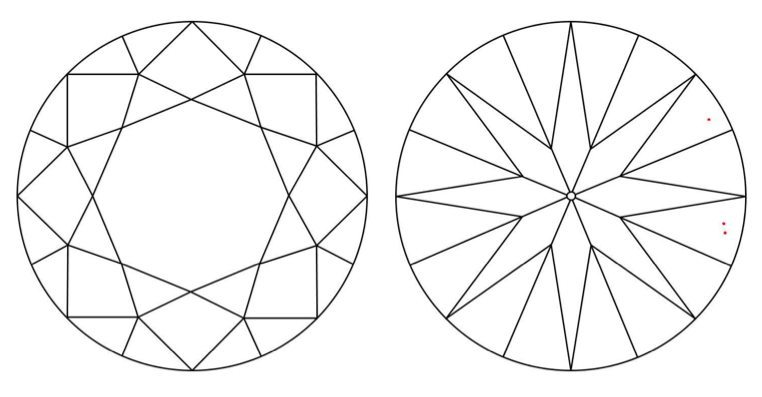
Many people place a lot of weight into getting a diamond with a nice clean clarity plot on the lab report like the VVS1 above. Notice there are only three pinpoint inclusions that can only be visible from the pavilion side of the diamond.
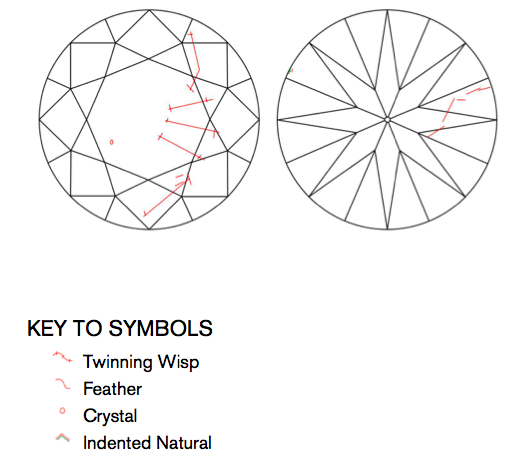
When compared to the VVS1, this SI1 diamond has a seemingly scary looking clarity plot, but a good looking clarity plot and a beautiful diamond has less correlation than one would imagine. The diamond above has a decent chance of being eye-clean.
There are several things you need to know briefly about the clarity plot. The first is that the clarity plot is labelled with the grade-setting inclusion first. The second is that internal features are labelled red and external features are labelled green. The plot is drawn to demonstrate the location and the extent of the inclusion and in most cases, does not reflect what the inclusions actually look like.
Common Inclusions
In general, inclusions that can only be seen from the bottom or inclusions that can be covered up with a prong are preferable to inclusions that are directly visible under the table. The most common types of inclusions are crystals, feathers, pinpoints, and clouds. You should focus on clouds and feathers which seem to worry people the most.
Clouds are simply many pinpoints grouped together. They are called clouds because they can make the diamond look cloudy. Small clouds made up of several pinpoints generally have no effect on the appearance of the diamond. But be extremely careful when you come across a clean clarity plot for a low clarity grade accompanied with the comment “clarity grade is based on clouds not shown”. There is a chance that the diamond in question has a cloudy look to it like the diamond below. Compare the diamonds below, the diamond on the left is cloudy and has no fluorescence. Please bear in mind that this is an extreme example.
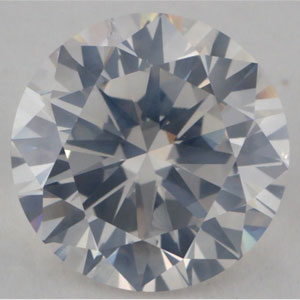
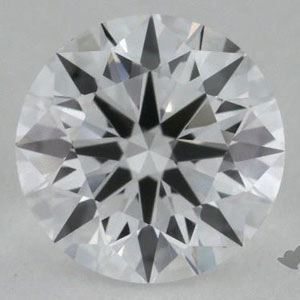
A feather is a fancy word for a crack that touches but doesn’t breach the surface of the diamond. Small feathers cannot be seen easily and can only be seen at particular angles, the reason people worry about feathers is more because they are concerned about durability risks. My opinion is that feathers in VS clarity grades are usually a non-issue.
In larger feathers, there is a chance that the feather can grow over time as it gets knocked around during normal wear and tear. If that feather breaches the surface of the diamond, it would pose an even bigger durability problem. Because of this, feathers seem to concern a lot of people and there are experts that will support the idea that some feathers are a durability risk.
However, most take the position that a diamond can have a huge feather and may never crack, but on the other hand an internally flawless diamond may crack if it is struck at a precise spot where it has a cleavage plane. So don’t worry about feathers and just treat every single diamond with care.
Less Common Inclusions
Some less common flaws but ones that seem to worry a lot of consumers are knots, naturals, twining wisps, and graining.
Knots are transparent crystals that extend to the surface of the diamond. They are more commonly found in SI clarity diamonds because there is a good chance that they are not eye-clean.
Naturals are a piece of the rough diamond that is left unpolished on the diamond. It is done to save weight. Naturals are usually external features, but an indented natural is classified as an inclusion. When naturals are near the girdle, they are fairly easy to cover using a prong when setting the diamond.
Twining wisps, which are more often associated with fancy shapes, but do sometimes appear in round diamonds. They can be made up of small crystals, pinpoints, and clouds. They are sometimes formed near the beginning of the diamond’s growth as a crystal itself when there is a common ‘twinning’ plane. The diamond grows out identically like ‘twins’, but in opposite directions, and that is why twining wisps often appear like a pair of inclusions as can be seen quite clearly between the arrows in the image below.
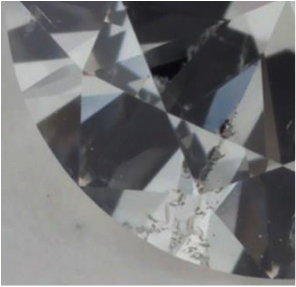
Graining can either be surface graining or internal graining, but both refer to grain boundaries that are formed as defects in the crystal structure. They can appear as a series of straight or curved white lines that may be visible under 10x magnification. Graining may appear scary to consumers because it is usually remarked as a comment “surface graining is not shown” or “internal graining is not shown”. We are always scared of the unknown.
Finally, a word on reflectors. A diamond’s facets are like mirrors and depending on where the inclusion is, it could be reflected once, twice, or several times. If an inclusion is reflected by a pavilion facet, even a small inclusion may appear like many inclusions and these types of inclusions are known as reflectors. Reflectors that affect the diamond face-up will be taken into account of in the grading process.
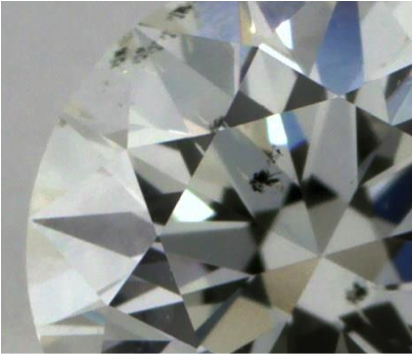
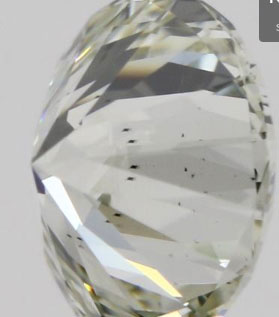
Notice how a dark inclusion inside the table can be reflected by one pavilion main onto all the other pavilion mains.
Conclusion
You should choose your specs wisely according to your budget. You would be foolish to buy a VVS2 diamond and end up having to sacrifice your other preferences. The most sensible clarity grade is the VS2 and you can go up or down depending on how much you value clarity. Also remember that the GIA sets the standard for clarity grading.
When buying a diamond online, clarity is probably the one characteristic that you have to rely on the labs for the most. Trust labs like the GIA and the AGS to grade a diamond’s clarity properly.
